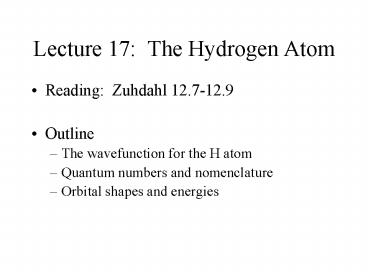Lecture 17: The Hydrogen Atom PowerPoint PPT Presentation
1 / 22
Title: Lecture 17: The Hydrogen Atom
1
Lecture 17 The Hydrogen Atom
- Reading Zuhdahl 12.7-12.9
- Outline
- The wavefunction for the H atom
- Quantum numbers and nomenclature
- Orbital shapes and energies
2
Schrodinger Equation
- Erwin Schrodinger develops a mathematical
formalism that incorporates the wave nature of
matter
Kinetic Energy
The Hamiltonian
d2/dx2
x
The Wavefunction
E energy
3
Potentials and Quantization (cont.)
- What if the position of the particle is
constrained by a potential
Particle in a Box
Potential E
0 for 0 x L
? all other x
4
Potentials and Quantization (cont.)
- What does the energy look like?
n 1, 2,
Energy is quantized
E
y
yy
5
Potentials and Quantization (cont.)
- Consider the following dye molecule, the
length of which can be considered the length of
the box an electron is limited to
L 8 Å
What wavelength of light corresponds to DE from
n1 to n2?
(should be 680 nm)
6
H-atom wavefunctions
- Recall that the Hamiltonian is composite of
kinetic (KE) and potential (PE) energy.
The hydrogen atom potential energy is given by
7
H-atom wavefunctions (cont.)
The Coulombic potential can be generalized
Z
Z atomic number ( 1 for hydrogen)
8
H-atom wavefunctions (cont.)
The radial dependence of the potential
suggests that we should from Cartesian
coordinates to spherical polar coordinates.
r interparticle distance (0 r ?)
e-
- angle from xy plane
- (?/2 ? - ?/2)
p
? rotation in xy plane (0 ? 2?)
9
H-atom wavefunctions (cont.)
If we solve the Schrodinger equation using
this potential, we find that the energy
levels are quantized
n is the principle quantum number, and ranges
from 1 to infinity.
10
H-atom wavefunctions (cont.)
In solving the Schrodinger Equation, two
other quantum numbers become evident
l, the orbital angular momentum quantum
number. Ranges in value from 0 to (n-1).
m, the z component of orbital angular
momentum. Ranges in value from -l to 0
to l.
We can then characterize the wavefunctions
based on the quantum numbers (n, l, m).
11
Orbital Shapes
- Lets take a look at the lowest energy orbital,
the 1s orbital (n 1, l 0, m 0)
- a0 is referred to as the Bohr radius, and
0.529 Å
1
1
12
Orbital Shapes (cont.)
- Note that the 1s wavefunction has no angular
dependence (i.e., Q and F do not appear).
Probability
Probability is spherical
13
Orbital Shapes (cont.)
- Radial probability (likelihood of finding the
electron in each spherical shell
14
Orbital Shapes (cont.)
- Naming orbitals is done as follows
- n is simply referred to by the quantum number
- l (0 to (n-1)) is given a letter value as
follows - 0 s
- 1 p
- 2 d
- 3 f
- ml (-l0l) is usually dropped
15
Orbital Shapes (cont.)
Table 12.3 Quantum Numbers and Orbitals
- n l Orbital ml of Orb.
- 0 1s 0 1
- 0 2s 0 1
- 1 2p -1, 0, 1 3
- 0 3s 0 1
- 1 3p -1, 0, 1 3
- 2 3d -2, -1, 0, 1, 2 5
16
Orbital Shapes (cont.)
Example Write down the orbitals associated
with n 4.
Ans n 4
l 0 to (n-1) 0, 1, 2, and 3 4s, 4p, 4d,
and 4f
4s (1 ml sublevel) 4p (3 ml sublevels) 4d (5 ml
sublevels 4f (7 ml sublevels)
17
Orbital Shapes (cont.)
s (l 0) orbitals
r dependence only
as n increases, orbitals demonstrate n-1
nodes.
18
Orbital Shapes (cont.)
2p (l 1) orbitals
not spherical, but lobed.
labeled with respect to orientation along x,
y, and z.
19
Orbital Shapes (cont.)
3p orbitals
more nodes as compared to 2p (expected.).
still can be represented by a dumbbell
contour.
20
Orbital Shapes (cont.)
3d (l 2) orbitals
labeled as dxz, dyz, dxy, dx2-y2 and dz2.
21
Orbital Shapes (cont.)
4f (l 3) orbitals
exceedingly complex probability distributions.
22
Orbital Energies
energy increases as 1/n2
orbitals of same n, but different l are
considered to be of equal energy
(degenerate).
the ground or lowest energy orbital is
the 1s.

